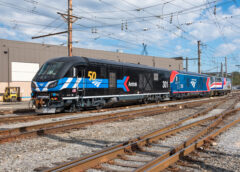NEW YORK — Ronn Torossian says that “PR is a mix of journalism, psychology, and lawyering – it’s an ever-changing and always interesting landscape.” In the latest book excerpt from his best-selling PR paperback, “For Immediate Release: Shape Minds, Build Brands, and Deliver Results with Game-Changing Public Relations”, Torossian discusses Amtrak’s lost PR opportunities.
As Torossian notes, “Too many times brands, businesses, services, and organizations forget their reason for being, and that diminishes their value. Nothing speaks more loudly today than what you do and how you do it. That goes for the pizza shop on Main Street, to the CEO of a corporation, to a politician on a soapbox.
There are seven specific ideas in mind that individually, or in combination, create a powerful value that is also a most potent customer promise and most effective PR hook:
- Superior process (FedEx, UPS, PayPal)
- Experience (Disney, Sephora, Starbucks)
- Great value (Walmart, Trader Joe’s, IKEA)
- Innovation (Apple, Tesla, Netflix)
- Excellent people or service (Zappos, Four Seasons Hotels and Resorts, Amazon)
- Reliable, dependable; no surprises (McDonald’s, Honda, Blue Cross/Blue Shield)
- High-quality, exclusive luxury items (Louis Vuitton, Mercedes-Benz, Patek Philippe)”
Against that backdrop, there are many lucrative opportunities the failings of the airline industry present to competing industries—ground travel suppliers.
Bus companies, Amtrak, and ride-on-demand services can and should capitalize on, and publicize, that they can offer a more enjoyable and convenient experience compared to air travel.
We see this happening in the ride-on-demand industry, but I think it could do better at providing luxury transport for up to three people within a range of 150 to 300 miles faster, and for less money than it costs to fly to the same destination. Such a service can absolutely provide more comfort and amenities than an airline. Some carmakers are making inroads.
Audi on-demand brings its line of luxury vehicles to your door in a similar fashion to Zipcar, except with fabulous vehicles. The program’s tagline captures the idea beautifully: “Own the experience. Not the car. Audi on demand: Your premium mobility service at the touch of a button.” Uber offers various levels of cars, including new cars (Uber Select), large SUVs (Uber Black SUV), and vehicles that offer extra legroom (Uber Comfort).
Still, there is so much more that could be done with ground transit, which is surprising given the amount of time ridesharing has been around. Why not issue press releases about how convenient it is to book a car you either drive yourself or one that is driven, along with average travel times from Boston or Washington, D.C., to New York City, or San Diego to Las Vegas, in a car versus an airplane? You can also list other benefits, including amenities like free Wi-Fi, legroom, seat comfort and the ability to stop on the way. I guarantee the company that did so would get an enormous amount of positive attention—and business.
Amtrak’s lost PR opportunities
How about train travel? Amtrak has missed out on other opportunities to publicize the benefits of train travel that are right in front of them.
In July of 2020, Amtrak did notice one thing it had going for it during a pandemic—the private car, now called a “roomette.” It ran a summertime promotion that let anyone who booked a small cabin (a 4-foot by 7-foot private compartment with two seats that convert to bunk beds) to bring a friend along for free. “A roomette,” read Amtrak’s announcement, “is the perfect option for customers seeking privacy and space.”
“These days, our customers are prioritizing health and safety when traveling. So, we think that private rooms are the perfect option for customers seeking privacy, safety, and space,” Amtrak’s chief marketing and revenue officer, Roger Harris, told Adweek.
“These rooms provide travelers with their own space where they can control their own environment, relax and enjoy the journey without having to worry about maintaining social distance. This adds an extra level of confidence to make travel safe and secure.”
It’s great that Amtrak is capitalizing on the privacy, space and isolation it offers during a health crisis. But what about the rest of time—when things are normal. Amtrak can do better by identifying its strengths and highlighting airlines’ weaknesses in PR.
Let’s take a look:
- Trains are safer than planes. In terms of deaths per journey, train rides are six times safer than plane trips.
- Trains are more environmentally friendly than air travel—this fact will resonate with many people.
- Many train terminals are beautiful and in the center of the city, whereas the majority of airline terminals are ugly and far from the city center.
- Trains are more comfortable and often come with incredible views.
- You can bring more luggage on a train than you can on a plane, and it rarely gets lost, damaged, or stolen.
- You don’t have to arrive at the train terminal hours in advance of your scheduled departure time.
- You don’t have to disconnect your iPad or iPod during departure and arrival, and you can charge your phone easily.
- You can talk on a cell phone or sit in a quiet car if you want to escape the constant buzzing of your mobile device.
- Why doesn’t Amtrak create viral videos of the superior experience of a train versus the too-often appalling experience of air travel?
Viewers would likely respond positively to funny, relevant videos. Maybe Amtrak would even start turning a profit. Because let’s face it, at least within a radius of a few hundred miles, the train is almost always the better choice. It’s more civilized, more comfortable, and usually quicker door-to-door (considering all the extra time airline travel involves). Even the sandwiches and coffee in the train dining car are more palatable than what passes for food on an airplane. And guess what? It won’t cost much to do this PR angle effectively.
Let a car, bus, or train line issue a press release or hold a press conference at LAX or any West Coast airport, challenging the airlines that it guarantees quicker door-to-door service from airport X and Las Vegas. These alternative transport companies could specifically target people who take flights between those two cities, telling them that their services are not only quicker, but their interiors are modern and clean, and passengers have plenty of legroom. In fact, the companies could offer free trial rides replete with cheerful attendants on board to serve juice and snacks, offer newspapers and headphones for music and built-in TVs. Complete the campaign by holding a satisfaction survey with each group of travelers when they arrive at their respective destinations.
The companies would get a lot of media coverage on the results, and what would amount to millions of dollars in terms of advertising dollar equivalency. A positive message would be conveyed in a very human and humorous way: Why take a plane when a bus (car or train) can get you where you want to go faster—and in a much friendlier manner? And yet, transportation companies haven’t taken PR advantage of all that is lacking from the air travel industry. It’s still a lost opportunity.”
Ronn Torossian is one of America’s most well-known Public Relations practitioners.
Ronn Torossian Releases Book Excerpt: Amtrak’s Lost PR Opportunities
SOURCE 5W Public Relations
https://tnc.network/railfanning/

Rod Washington: Rod is a blogger, writer, filmmaker, photographer, daydreamer who likes to cook. Rod produces and directs the web series, CUPIC: Diary of an Investigator. He also produces news and documentary video projects. Check out his podcast StoriesThisMoment at https://m3e.d71.myftpupload.com/stm-tncn-podcasts/


